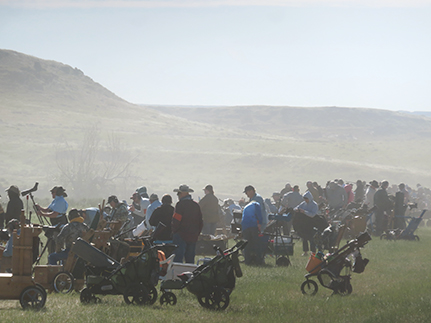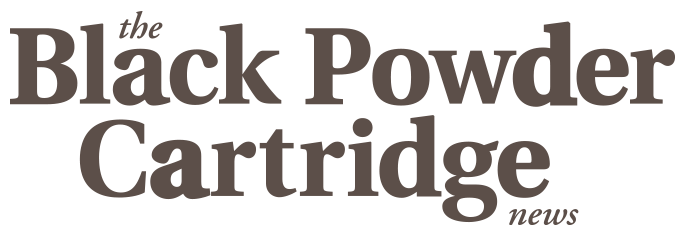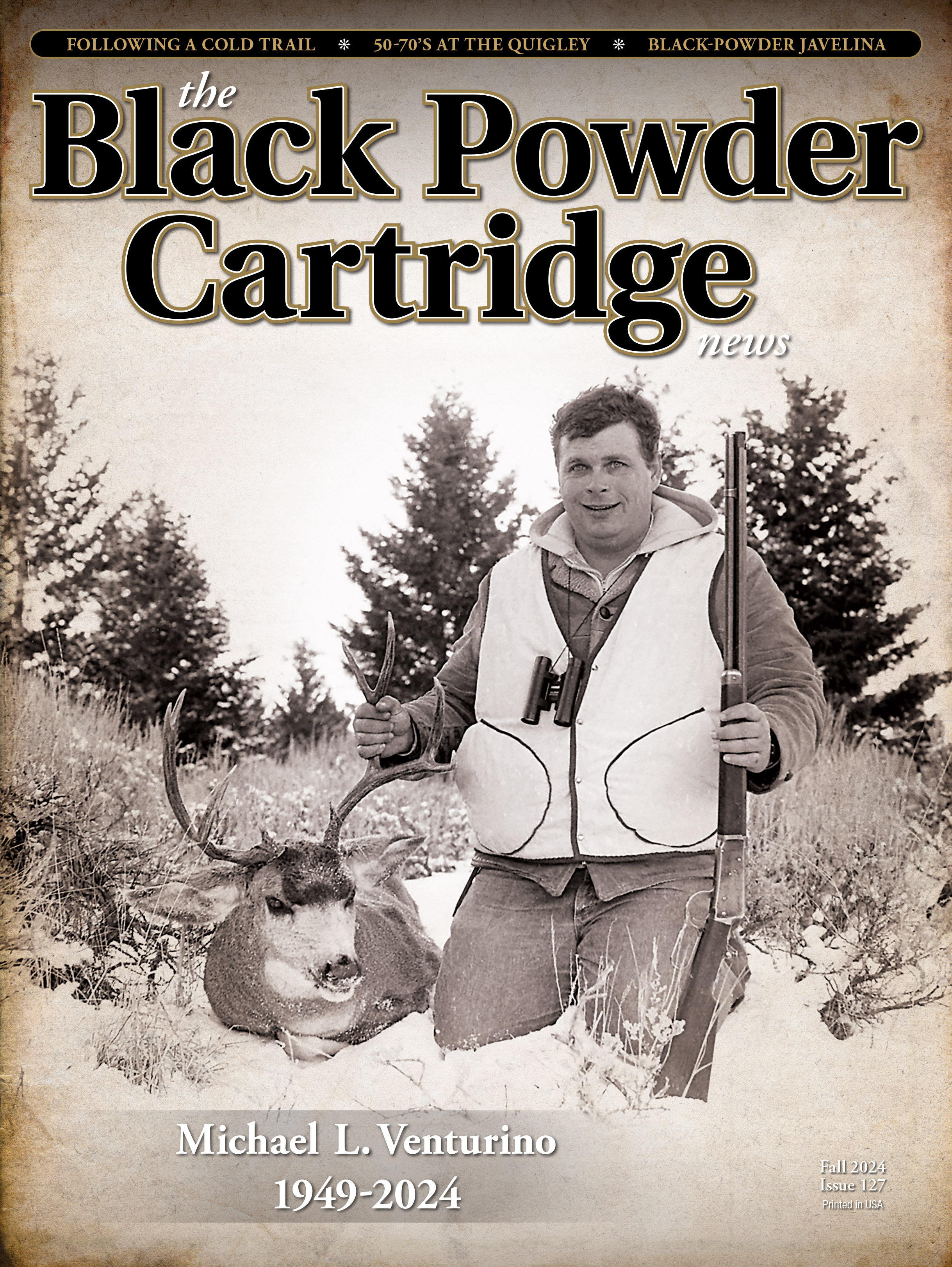Sharps 50-70s at the “Quigley”
feature By: mike Nesbitt | September, 24
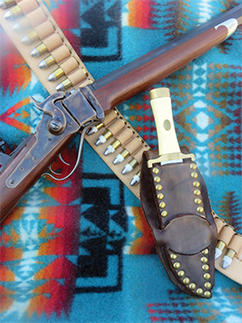
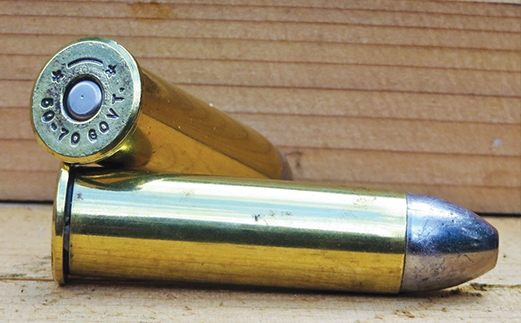
Back in 2021, I used my 50-70 Sharps at Quigley, which gave me a head start on Mike with his rifle. The only advantage I had was in my notes from three years ago for the elevations at the Quigley distances, and I was certainly eager to share those. Old notes, of course, are probably in need of updating for one reason or another. For one thing, I’d be shooting at those targets with a different eye and left-handed for the first time at Quigley. Also, I’m not sure that my loads are close or even the same. That said, those old notes would still give us some starting points.
Back in 2021, while on our way to Quigley, we stopped at C. Sharps Arms in Big Timber, Montana, to pick up my 50-70, the rifle I named “Moonbeam”. After much back and forth, I decided to use it in that Quigley match. The first couple days at Quigley were spent sighting it in. Our first competitive target was the Bucket at 350 yards, which I only hit once, but at least I hit it. Then we moved to the Buffalo at 805 yards and I scored on that target three times. For the Octagon, I scored five hits, then four hits on the Postage Stamp, followed by six hits on the Diamond, and finally finishing with just three more hits on the second Postage Stamp. This gave me 22 hits with the 50-70, which was one more hit than what I had managed with “Hefty Hannah” two years before.
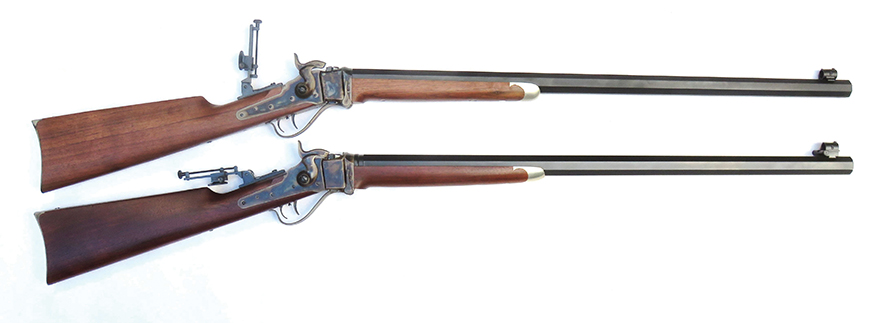
This year, Allen Cunniff and I arrived at “Quigleyville” a couple of days before Mike Moran and his travel partner, Jim Haeckel. To make sure we would all be shooting in the same group, I registered our names together. At Quigley, you must be a registered shooter before you can fire any practice shots. The squadding is done on Friday, before the match starts on Saturday morning. “Squadding” is when you select your shooting position within the squads of six shooters, which allows you and your partner to do the spotting of your shots at the same time. For this big match, registration and squadding are certainly important and easily done.
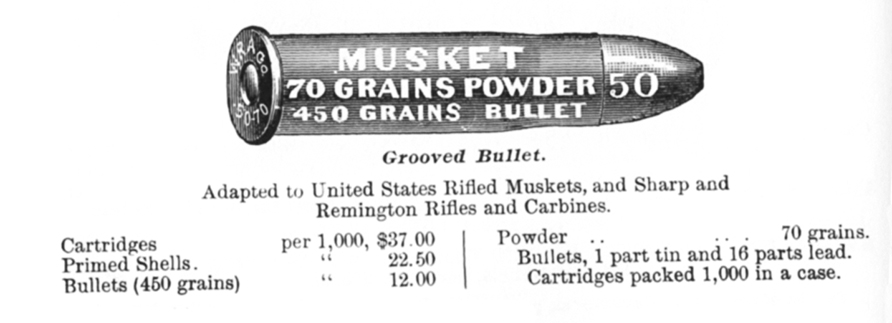
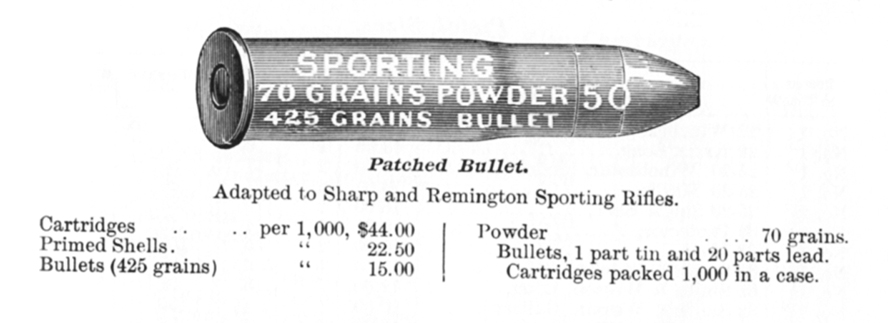
Both of our rifles were equipped with Deluxe Mid Range Vernier tang sights made by C. Sharps Arms. Those sights proved to have more than enough “reach” for our shots on the buffalo target at Quigley, which is just beyond 800 yards.
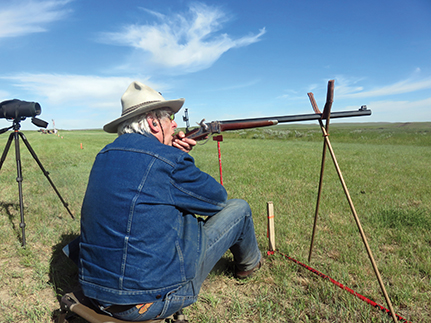
Mike’s load was slightly different. He was putting 68 grains of Swiss 1½ Fg in his 50-70 and was using a slightly heavier bullet; it was another of Accurate Molds’ bullets, No. 52-460N, with its wider flat point. The small difference in our loads probably wouldn’t be noticed on the firing line.
While comparing notes, we’d often see if our two rifles needed similar sight settings for the various distances on the targets at Quigley. Mike’s rifle consistently used lower sight settings than my rifle. The main reason for that was not the difference in our loads, but rather Mike’s rifle has a slightly lower front sight than mine, which must be “echoed” in his elevation settings on his rear sight.
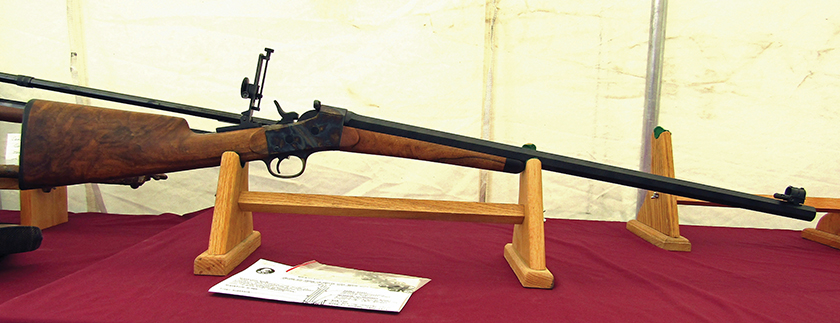
Now, more about this year’s Quigley shoot. Allen Cunniff and I arrived in camp on Monday. We had the tent set up and most of our gear stashed, when Al Kajin popped his head into the tent to tell me that Mike Venturino had passed away the previous day. Mike Venturino, as many of you know, was the winner of the first Quigley Buffalo Rifle Match back in 1991, when the Quigley shoot first got started. Mike gave Tom Selleck some tips and instruction on how to shoot and handle the Sharps rifle before the movie “Quigley Down Under” was filmed. We could say that Mike Venturino left his footprints all over the Quigley matches and will be sorely missed. This sad news was on the “down side” for this year’s Quigley.
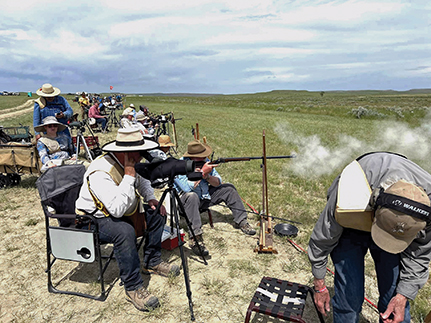
Allen and I started our practice shots at the Diamond (405 yards) then moved to the 417-yard Rectangle, the second Postage Stamp and finally the Bucket. To get a sight setting, I took my practice shots at the Bucket from a sitting position, making sure the elevation for the rear sight was written down.
Mike Moran and Jim Haeckel pulled into camp on the following day. Mike’s tent added more canvas to our gathering of the Black River Buffalo Runners. Then Scott and Cathy Sibley from Wyoming, showed up with their single-pole Sibley tent, as well as Phil Wiebe from Washington, which added even more canvas. Mike Holeman and Larry Litten also joined us, camping nearby in a nice big RV.
Then, as soon as they could, everyone headed to the firing line for some practice shots. Mike Moran had never fired his 50-70 at Quigley and this was Jim and Larry’s first trip as well. They all needed full and complete notes before the match started, leaving them just over two full days to get that done.
Mike and I didn’t practice together, although we often compared notes back at the tents. Our rifles and loads were very similar and I’m not going to say that we were the only ones there with 50-70 rifles, but we were the only ones we knew about. Those 50 caliber rifles did have a sound all their own on the firing line; no “crack” at all, just a big sounding “boom”.
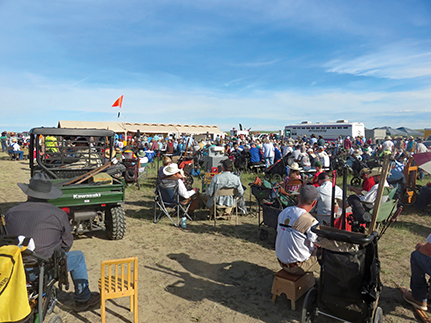
Late on Friday afternoon, we held the camp burger feed with antelope burgers furnished by Scott and Cathy Sibley. Once more, I did the cooking on the grill heated by Scott’s propane burner and there was about 20 people enjoying the meal, including Al and Claudia Kajin.
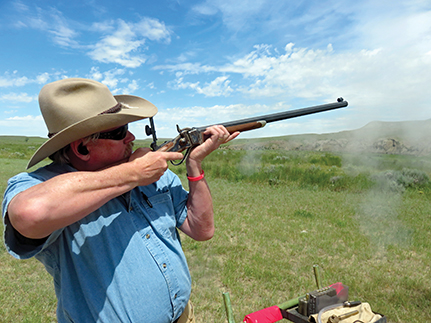
Mike also had a second rifle, his 45-70 Sharps that he used last year. Just like with Hefty Hannah, his back-up rifle was not needed either.
At the shooters’ meeting, we learned where our group would start in the match. We’d start on the Postage Stamp, which follows the Diamond. We considered that good, because we’d be shooting at the Bucket, the only offhand gong in the match as our second target. I can’t tell you how well Mike did on the rectangle but I, for one reason or another, only got one hit.
Let me admit it, I’m not a contender for the top prize at Quigley. My personal goal was to simply beat my low score of only nine hits from last year. You might remember that last year I tried shooting with a scoped 45-70, hoping the new MVA scope would make a difference, but my right eye just didn’t have what’s needed. So, this year, I went back to iron sights to help aiming with my left eye. To me, that was really like starting over again.
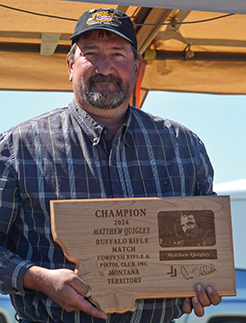
When it was my turn to shoot (with Mike spotting for me) I had the midrange sight dialed in at 1.57, almost to the top of the ladder, which told me that my 50-70 could lob a bullet to the 800-yard targets, but not to 1000 yards, unless a long-range sight was used. My first shot was a miss, right under the critter’s chin. With that information to help, my next shot “made meat”. After firing my eight shots at the buffalo, Becky Berdahl, our scorekeeper, gave me credit for three hits. Mike, again, shot better than I.
Our next target was the Octagon at 600 yards, our last target for the day. My shooting didn’t improve much but I did get another three hits. Right after finishing my shots, I headed back to the tents and I’m glad I did, as that was when the big wind and dust storm hit. Yes, Quigley is noted for the winds in that area, but this was something more; it was such a storm that it even made the news. Scott Sibley and I were the only ones in camp and seeing the storm coming, we got busy taking down the canvas awnings, rather than have them torn down by the wind. Doing so saved the tents. While that was happening, some shooters were still trying to see the targets through the flying dust … that’s Quigley for you!
Later that night the wind and dust died down, allowing me to get a little sleep. The morning of our last day in camp, we started packing up even before heading back to the firing line. Our group still had two targets to shoot; the 530-yard Postage Stamp and the 405-yard Diamond. However, the winds were not completely finished and those targets were shot in a fairly strong wind coming in from the left. So, my method of holding the target’s white dots outside of the front aperture was used again, which gave me just two hits per target.
While I was not one of the winners at Quigley, I certainly do tip my hat to those good shooters, especially the winner, Shane Kraft. However, I feel rather good about my shooting because I managed to beat my last year’s score by four hits, which gave me a total of 13. That score is certainly in the right direction. Out of approximately 575 shooters this year, maybe my score will put me in the top 500. To find out, go to quigleymatch.com to see the scores. Also, it pleased me that Mike Moran got 21 hits, using his 50-70 rifle for the first time. We certainly enjoyed the match enough to use our 50-70 rifles at Quigley next year
